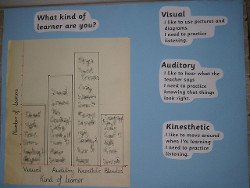Vocabulary Strategies for Visual, Auditory, and Kinesthetic Learners
I am a visual learner. I learn best through seeing words, text, slides, pictures, graphics, outlines, charts, diagrams, lists, notes, basically anything that I can observe or read. I do like to learn by touching and experiencing things (kinesthetic learning), but I tend to learn better when there’s something for me to read, too. I’m a terrible auditory learner. I find it hard to focus in lecture-style settings and I always struggle to remember the things I’m told. But if I’ve read it somewhere, there’s a good chance I’ll remember it.
 It took me a long time to figure out my preferred learning style. I know that the theory behind learning styles is hotly contested, but I have found the visual vs. auditory vs. kinesthetic learning distinction to be helpful both for my own learning, and for when I’m working with students.
It took me a long time to figure out my preferred learning style. I know that the theory behind learning styles is hotly contested, but I have found the visual vs. auditory vs. kinesthetic learning distinction to be helpful both for my own learning, and for when I’m working with students.
When it comes to vocabulary instruction, most of the commonly-used instructional techniques, particularly at the middle school and high school levels, tend to favor visual learners, i.e., learning words in context as you read, studying vocabulary wordlists or flashcards, doing vocabulary practice problems, reviewing vocabulary cartoons and memes, etc. That’s not a surprise since 65% of people are visual learners. Plus, vocabulary = words = text-based, making it an inherently visual medium.
But, what can we do for all the auditory and kinesthetic learners? Here are some ideas:
Auditory Learners
 Provide Verbal Explanations: For auditory learners, encountering a new word (even if it’s via personally meaningful context) and reading its definition may not be sufficient. Hearing the word pronounced and listening to a verbal explanation of the word can help students better process the learning.
Provide Verbal Explanations: For auditory learners, encountering a new word (even if it’s via personally meaningful context) and reading its definition may not be sufficient. Hearing the word pronounced and listening to a verbal explanation of the word can help students better process the learning.- Play Quiz Games: Games like vocabulary jeopardy, that involve listening to clues, providing verbal explanations, and hearing words repeated, can really help auditory learners.
- Listen to Music: Vocabulary cartoons and memes are extremely popular for visual learners. For auditory learners, listening to vocabulary videos and music may be equally helpful. Check out Flocabulary for videos on teaching vocabulary via hip-hop music.
Kinesthetic Learners
 Vocabulary Twitter Account: This is an updated version of the classic word wall. Instead of having students post vocabulary words on a shared wall in the classroom, create a shared Twitter account or hashtag, and have students take turns nominating vocabulary words of the day and using those words in sentences.
Vocabulary Twitter Account: This is an updated version of the classic word wall. Instead of having students post vocabulary words on a shared wall in the classroom, create a shared Twitter account or hashtag, and have students take turns nominating vocabulary words of the day and using those words in sentences.- Vocabulary Post-It Notes: Of course, it’s never a bad idea to sneak in some extra vocabulary learning opportunities in the classroom. Use post-it notes to create associations between vocabulary words and items around the room and let students discover them on their own time. For example:
- Stick defenestrate on the window to remind students that defenestrate means to throw someone or something out of a window. It’s often used in reference to throwing politicians out of office.
- Stick elucidate on the light switch. As students turn on the light, hopefully they’ll think about how elucidate means to shed light on something or to make things more clear.
- Stick egress on the door. P.T. Barnum famously posted the sign, “This Way to the Egress,” in his museums. Visitors would follow the sign, expecting to see a new exhibit, only to learn that egress means exit.
- Stick disseminate on your phone. It’s probably the main device you use to share and spread info.
I’d love to hear your suggestions! What are your favorite tips to help auditory and kinesthetic learners with vocabulary?
Let me know @professorword!
Until next time,
Follow EdWeek Market Brief on Twitter @EdMarketBrief or connect with us on LinkedIn.
See also:
- Beyond Fiction: Expanding What Counts as Meaningful Student Reading
- Words Mean More to Students When They’re Personal
- Students Can Learn Vocabulary as They Read Online
- My Unlikely Road to Entrepreneurship
- What’s in a Startup Name? How to Choose One That Fits Your Company
Have questions or feedback? Comment below or let me know @professorword!
Photo Credit: Flickr user lindah, Shawn Smith, and 3oheme.

When I taught at The New Community School, absolutely every lesson was imbued with visual, auditory and kinesthetic involvement.
When I left, I plopped some of my lessons online, including http://www.resourceroom.net/Comprehension/wordparts/index.html … I fondly remember the student who managed to draw *every* vocabulary meaning into the context of police officers and doughnuts…
Algihrt alright alright that’s exactly what I needed!
unde au chestiile pt. prajituri: zaharul pudra vanilat, chestiile de ornat de pus pe muffins, esentele etc. ; sunt chiar in capatul culoarului, inspre casele de marcat, niste borcanele mici cu cirese intregi in ele; auzi, dar mai bine fac o poza si ti le arat, lol :))
de NVP leden houden zichzelf toch alleen aan deze uit de tijd regel? Is geen algemeen bindende regel m.i.. En alles wat je kan weten moet je weten toch?
Chris — you and me, Dude. I'm on the ground. We can sit with our popcorn and watch the rest of these suckers plummet to their deaths.Roxanne. Seriously? Go you. You would take some amazing pictures. Chris and I will hold your purse.Jenni — you are kuh-RAY-zee!!Christy, I may– MAY — consider a tethered ride. Maybe. If Chris will hold my purse.
Edie, what a wonderful testimony of God’s presence in your life. What an amazing response to such a life-changing situation. We have been so blessed to know you and Noble. God’s blessings on you both today.
Hey, you used to write fantastic, but the last several posts have been kinda boring… I miss your tremendous writings. Past couple of posts are just just a little bit out of track! come on!
my preferred learning style
Amazing Article. I am an auditory personality. I will use the technique describe above to enhance my vocabulary power.
Lovely article
That’s what i wanted. Thanks
Amazing Article. I am an auditory personality. I will use the technique describe above to enhance my vocabulary power.
Was looking for this from long time. Kudos for this post.
you are actually a good webmaster. The website loading velocity is amazing. It seems that you are doing any distinctive trick. In addition, The contents are masterpiece. you’ve done a excellent process on this subject
express vpn best free vpn for android https://apkgameapps.com/apps-android/express-vpn-apk/
you are actually a good webmaster
nice article!! thanks for this wonderful content!! My site: Ultra gamers
A great article also useful one
“For instance it adds Cash,Clams and Unlock All Characters and Outfits which are fully plain indispensable in Household Man The Quest for Stuff.”
Never allow limitation to your studies because every subject has its own value and importance. While attempting to do your maths assignments https://acemyassignment.co.uk/ or any other you need to make sure that you hired the expert.
About… This is a great VPN. I used it when I watched movies through Showbox. But that’s just recently Showbox does not work. Do you want to know why? Then you should definitely read this article https://pipsli.net/en/android-apps/multimedia/125-showbox.html
Showbox is a great app that streams movies, music, and TV shows. This software is one of the most entertaining applications that we have.
I’ve read your article, and need to say – this really
is a real gem. The previous time I have
come across something both well-written was https://www.freeessays.education/essay-examples/people-of-america/.
Your material is actually a fantastic read, many thanks.
Wish you a large audience and inspiration to get further posts.
It is in point of fact a great and helpful piece of info. I’m satisfied that you just shared this helpful information with us. Please stay us informed like this. Thanks for sharing.
cloriquine https://chloroquineorigin.com/# hcqs tablet